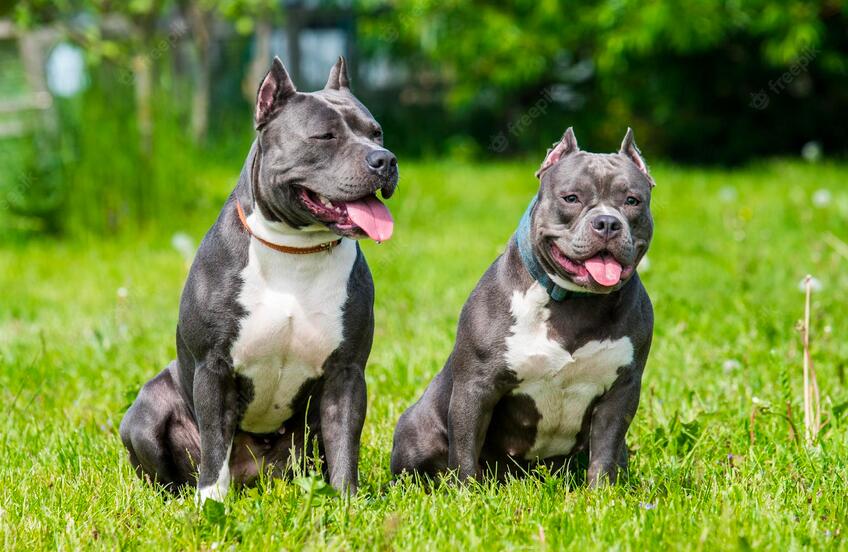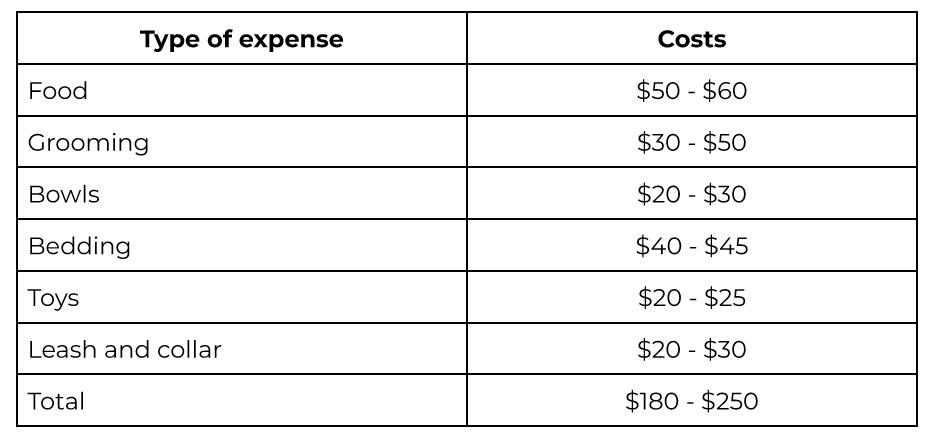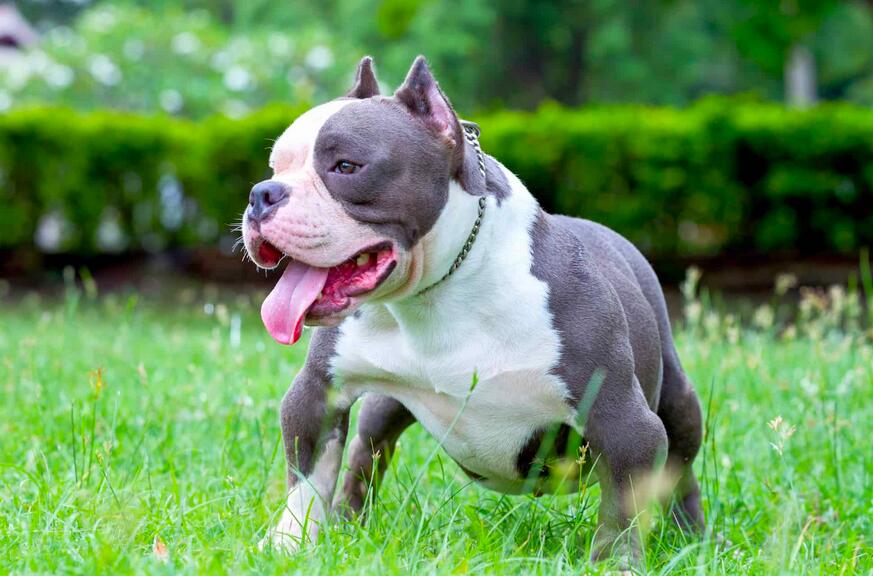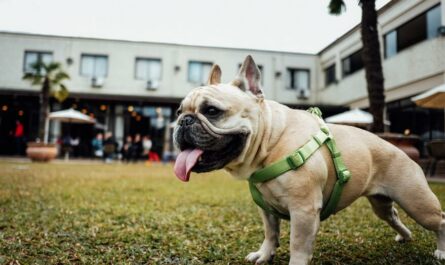The Blue American Bully is a popular breed known for its intelligence, loyalty, and striking blue coat. It is a unique and dynamic breed with a strong, muscular body. Its bright blue coat, powerful build, short muzzle, and wide head make them stand out against all other dog breeds.
In addition, the Blue American Bully is an excellent choice for those looking for a loyal, intelligent companion. With the proper training and socialization, they make great family pets. If you are interested in owning one of these beautiful dogs, it’s essential to research the breed before bringing one home.
What is a Blue American Bully?
A Blue American Bully is a specific color variation of the American Bully breed. It is a breed of dog that was developed in the United States. It is a hybrid breed created by crossing the American Pit Bull Terrier and the American Bully.
The Blue American Bully has a muscular body and a large, square head. Its coat can range from light blue to dark blue and may contain white markings. The eyes are usually brown or hazel, and the ears are typically cropped.
Its color isn’t necessarily blue, as people may think. Blue American Bullies are often born with a bluish-silver coat instead of solid blue.
Genetics And Breeding
When it comes to the genetics of blue American Bullies, the alleles usually determine the coat color passed down from the parents. The B gene is responsible for producing the blue coat color in dogs, and if both parents possess this gene, then their offspring will likely be born with a blue coat. However, if only one parent has this gene, their offspring may be taken with a different coat color.
It’s essential to ensure that both parents have been health tested and cleared of any genetic diseases or abnormalities that could be passed down to their offspring. Additionally, it’s essential to identify dogs with good temperaments and socialization skills to ensure that puppies are raised in a healthy environment.
Finally, knowing any regulations or laws about breeding dogs in your area is essential. Before starting, research any local laws or regulations that may impact your ability to breed blue American Bullies.

5 Most Common Types of Blue American Bully
Aside from the most common bluish-silver coat, Blue American Bullies also come with other hues.
1. Blue Fawn Bully
These bully dogs have a silver-gray coat that people often think of when it comes to Blue American Bullies. The colored fur covers most of their bodies while leaving some underneath parts in white.
2. Blue Brindle Bully
As its name might suggest, this bully is born with a bluish coat with a Brindle effect, which results in a stunning tiger-like stripe pattern on its body. The Blue Brindle Bully puppies are rare and expensive.
3. Blue Nose Bully
A Blue Nose Bully has a nose the same color as its coat. Of course, the color isn’t ocean blue, but some shade of gray. It can also be black.
4. Blue Merle Bully
Blue Merle is a unique coat with blue dots scattering over a solid color – usually black. However, this color variation isn’t desirable due to the health variations associated with the Merle gene.
5. Tri-color Bully
This bully comes in three colors; the dominant colors aren’t necessarily blue. It can also be brown or white. Tri-color bullies are among the rarest colors for Blue American Bullies you will ever come by.
Physical attributes
In the section below, let’s discover what a Blue American Bully dog looks like.
1. Appearance
The color variation doesn’t affect other physical attributes of the American Bullies. In other words, Blue American Bully dogs share the same appearance as other American Bullies.
You can easily recognize any Blue American Bully from its square-shaped jaw, pointed ears, broad chest, and muscular body. . Its coat is short, stiff, and glossy. Overall, it looks fierce and may scare off the kids.
2. Size
American Bullies have a wide variety of sizes, four of which are recognized by the American Kennel Club. Check out the table below for an idea of each size’s height and weight.

As you can see, the Pocket is the smallest variation of the American Bully dog. It is about 13 – 17 inches long and 20 – 65 pounds heavy. The Standard and Classic dogs may have the same height, but the former tends to be more muscular. The XL has the biggest frame, which may seem intimidating to some.
There are also other sizes of Bullie,s as follows:
- XXL Bully: It is the largest size of Bullies, which can be over 23 inches long. The AKC doesn’t recognize it due to its possible health issues.
- Extreme Bully: The word “extreme” refers to the muscular build of a Bully of any size.
- Micro Bully: Any Bully smaller than a Pocket Bully is considered a Micro Bully.
3. Temperament
Blue American Bullies are loyal, outgoing, and playful. They are tolerant of humans; therefore, they can be considered great companion dogs for well-rounded kids. These bullies are intelligent and can be trained quickly.
Blue American Bully needs plenty of exercise every day. Training them early to avoid any behavioral issues when they grow up is advised. The breed is intelligent and loves to play and interact with humans. It is loyal and protective but can also be affectionate and gentle with its family.
How much is a Blue American Bully?
Blue American Bullies can average costs anywhere from $2,500 to $10,000. However, even more, expensive dogs cost up to $10000!
Here’s a table that summarizes the average price of each Blue American Bully variation.

The exact price tag of these dogs depends on the color variations, breeder, rarity, health conditions, etc. Even the size will play a role in determining how much a Blue Bully costs.
For example, Blue Merle and Blue Tricolor Bullies often come with a hefty price tag as they are rarer than other coloring.
Other expenses of raising a Blue American Bully
Of course, more expenses are considered when you raise a Blue American Bully. They need high-quality food and other essentials,s such as toys and bedding,g to grow up happily.
Let’s look at the roughly estimated initial expenses of adopting a Bully.

As you can see, you need to pay about $180 – $250 when first bringing your bully puppy home. Consider the monthly recurring costs, such as food and grooming essentials.
Don’t forget to put aside some money to do regular pet check-ups.
Due to recessive genes, Blue American Bullies are prone to several health issues. Therefore, regularly taking bully dogs to the vet is essential to ensure they are healthy.
Is a Blue American Bully a Pitbull?
It can be Yes and No. The answer depends on how you define the word “Pitbull.”
If you associate Pitbulls with four breeds, including American Bully, Staffordshire Bull Terrier, American Pit Bull Terrier, and American Staffordshire Terrier, then Blue American Bully dogs are technically Pitbulls.
However, if Pitbulls are short for the American Pit Bull Terrier breed, Blue American Bullies can’t be considered Pitbull. Since the latter case is more common, Bully breeders don’t call themselves Pitbull breeders to avoid confusion.
In short, a Bully can be technically considered a Pitbull, but a Pitbull is not a Bully.
Are Blue Bullies dangerous?
Blue American Bullies aren’t dangerous at all.
People often associate Bullies with Pitbulls, so they may think Blue Bully dogs are aggressive and dangerous to humans. American Bullies were purposely bred to be companion dogs. Despite its muscular body, it is pretty friendly and affectionate.
It is still recommended to check with the breeder before you adopt any Blue American Bully. If possible, you should meet the parent dogs. Playful dogs will likely give birth to offspring with the same temperament.
What is the difference between a Blue American Bully and an American Bully?
The American Bully and the Blue American Bully are two different breeds of dogs derived from the American Pit Bull Terrier.
However, the two breeds have some distinct differences. The American Bully is a newer breed bred for its muscular and aggressive look. At the same time, the Blue American Bully was developed by breeding two American Bullies with unique blue coat colors.
In addition, the Blue American Bully is a variation of the American Bully. It has a more pronounced muscular and aggressive look than other bully breeds.
In terms of temperament, both breeds are generally friendly and loyal to their owners. They make great family pets and can get along well with other animals if socialized properly.
What is the joint problem associated with blue American Bullies?
Blue American Bullies may have joint issues. Hip dysplasia is one of the leading joint problems associated with blue-American Bullies. This condition is caused by hip joint malformation and can lead to great pain and immobility. Other joint issues affecting these dogs include luxating patellas, elbow dysplasia, and arthritis.
To help prevent your blue American Bully from developing these conditions, it’s essential to keep them at a healthy weight and provide them with plenty of exercise. If you suspect your dog is experiencing joint problems, visiting the vet for an examination and diagnosis is essential. Your vet can recommend treatment options based on your individual dog’s needs.
Are Blue American Bullies Easy To Train?
American Bullies typically desire to please their owners, so they are often eager to learn. They also have a strong work ethic, so they are quick learners and will strive to complete tasks to your satisfaction. Additionally, they tend to respond well to positive reinforcement and reward-based training methods.
At the same time, American Bullies can be stubborn and independent, so staying consistent with your training approach is essential. You should also be aware of their strong prey drive, as this can make it difficult to train specific behaviors, such as not chasing after other pets or wildlife.
How to take care of the Blue American Bully?
Blue American Bully dogs require attentive care to be healthy. When raising a Blue Bully, you should follow the recommended training, diet, and grooming advice below.
1. Training
It would help if you walked your dog or brought him for a light job for 20 – 30 minutes daily. It suits his health and allows you to bond with your dog.
In the summer, you can take your American bully to a swimming pool to let them cool off.
Like other dog breeds, obedience training should be carried out early. It is advised to enroll your bully puppy in a dog class so that he can learn basic commands. If your dog has any signs of misbehavior, you should seek a specialized behavioral training class instead.
2. Diet
Blue Bullies require enough protein to keep in shape. While puppies should have four to five meals daily, an adult Blue American Bully can do well with two cups of dry food.
Here’s what you should include in the diet of Blue American Bullies:
- Meat: Eating meat will ensure bully dogs have enough protein to grow their muscles. You can feed your dog beef, chicken, lamb, or turkey.
- Vegetables: Some bully dogs are allergic to meat, so feeding them vegetables such as carrots and potatoes is better.
- Fish: A fish diet helps maintain a glossy coat for bullies. Ensure to include other foods because sin-critical fish may lack some essential nutrients.
Besides, bully dogs should consume vitamins, minerals, and supplements to absorb essential nutrients for growth.
3. Grooming
Like any other bully, you should groom some critical areas of the Blue American Bully regularly:
- Coat: You should brush the coat of bully dogs twice a week to remove dead skin and keep their coat glossy.
- Teeth: Use a canine toothbrush to brush their teeth once a week to maintain their dental health.
- Nails: Make sure you trim their nails at least twice a month.
Closing thoughts
The American Bully is an assertive, alert, and loyal companion, and its high energy and enthusiasm make it an excellent choice for an active family. The Blue American Bully can be a loving and devoted companion for years with proper training and socialization.





